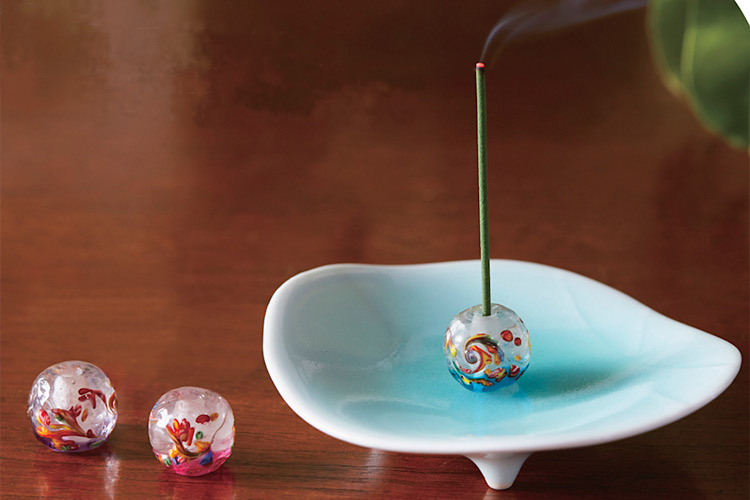ReservationSearch and reserve rooms
Click here to confirm, change or cancel your reservation
Shinkansen accommodation plan
提携法人専用予約
2024.05.31
"Sangetsu Kobo" connects Izumi Dragonfly Balls to the next 1000 years
NEIGHBORS

Izumi Dragonfly Beads have a history of over 1000 years in Osaka. The colorful glass beads with intricate patterns have a beauty that captivates anyone who picks them up. In 2002, their long-standing historical value was recognized and they were registered as a traditional craft designated by Osaka Prefecture.
Currently, Izumi Dragonfly Balls are only made by traditional craftsman Yuriko Matsuda. We visited the Izumi Dragonfly Ball Specialty Shop, Sangetsu Kobo, where Matsuda continues the tradition.
What is Izumi Dragonfly Ball?

Izumi Dragonfly Beads are glass beads that have been made using the techniques, methods, and materials that have traditionally only been made in Izumi Province (present-day Senshu region). Just being made in present-day Izumi City does not qualify as Izumi Dragonfly Beads.
"Normal glass beads are made by melting a single glass rod over a gas burner, but Izumi glass beads are made by bundling several glass rods together and heating them over a special burner that has been used for generations."

The journey I walked with my great mentor and father

Following the death of the previous owner, Sangetsu Kobo now has two traditional craftsmen. The previous owner was Yushiko's father, Tokiharu Komizo. He started visiting the factory from an early age and naturally decided to become a craftsman himself.
However, around 1997 (Showa 52), the Izumi Dragonfly Beads culture was on the verge of disappearing. Izumi Prefecture used to be a prosperous region due to its glass industry, but the number of glass craftsmen dropped dramatically due to the influx of cheap foreign products. When the Heisei era began, Tokiharu Komizo was the only professional glass bead craftsman left.
The two began their historical preservation efforts in order to ensure that the history and techniques of Izumi Dragonfly Balls would not be lost, but the road they took was by no means smooth.
"It took about 10 years to prove that the Izumi Dragonfly Glass Beads technique has been passed down to us, by tracing back through historical documents and finding the original glass beads made long ago," says Matsuda. After a long journey, the glass beads have been certified as a traditional craft by Osaka Prefecture.
Involved in restoring national treasures and began pursuing further technology

Due to its technical capabilities in glass bead production, Sangetsu Kobo was once entrusted with the task of restoring the Yoraku, a solemn ornamental item in the Phoenix Hall of Byodo-in Temple.
Restoring a yoraku, which is made up of glass beads of various colors and sizes, is no easy task. Matsuda looks back on the difficulties he faced at the time as follows:
"It was really difficult to reproduce the colors and shapes of the glass beads from that time. They were made using technology from 1,000 years ago, so there were a lot of misshapen glass beads. Unlike commercial production, it was difficult to deliberately create asymmetrical glass beads."
The glass beads of the Phoenix Hall represent the thoughts and dreams of people who lived 1000 years ago. Having successfully restored their brilliance, Sangetsu Kobo has embarked on a new challenge: the development and restoration of glass materials.

"The glass materials used to restore the national treasures were made a long time ago in the Senshu region, and are no longer available. Glass materials have characteristics that vary by region, and if the composition is different, they will not melt together and will break. In order to ensure that the memories of the people of that time are not lost, we have launched a project to develop and reproduce glass materials."
The name of the finished glass material is "Sen no Toki," which means "a thousand times." It is a reproduction of glass from 1,000 years ago, and is named after one character each of Matsuda's parents' names (Chisa and Tokiharu).
To connect the Izumi Dragonfly Ball to the next 1000 years

How can we preserve the techniques of Izumi Dragonfly Glass, which have been handed down for 1,000 years, for the next generation? Matsuda says that in addition to reproducing the glass material and passing on the techniques, it is also important that the glass continues to be accepted by people today.
"In order to preserve Izumi Dragonfly Balls, they need to be seen as good by people living in the present day. I want to make products that meet the uses and needs of the modern era while preserving the traditional techniques. I want my daughter, who is currently training to be the third generation to take over the business, to be conscious of the same thing."
The most popular items in the store are the "Seven-Colored Charms" and "Incense Holders." The charms, which are made from old-fashioned netsuke charms that can be easily carried as key chains, and the incense holders, which are used to burn incense instead of aromatherapy, are items that help us to become closer to traditional crafts.

Seven-colored charms

Incense burner
If you visit Osaka, please try picking up an Izumi Dragonfly ball. Sangetsu Kobo will continue to take on the challenge of passing on the Izumi Dragonfly ball, which has been passed down for 1000 years, to the next 1000 years.
*Izumi Dragonfly Ball is a registered trademark of Sangetsu Kobo.

Izumi Dragonfly Ball Specialty Shop Sangetsukobo Sakai Higashi Branch
Phone: 072-224-2670
Address: 2nd floor of "Kishida Stationery", 1-4-25 Nakagawaracho, Sakai-ku, Osaka
Access: 5 minutes on foot from Sakai Higashi Station on the Nankai Koya Line
HP: https://izumi-tombodama.com/
Social Media: https://www.instagram.com/izumi_tombodama/
*For details on business hours and holidays, please check the link above.



